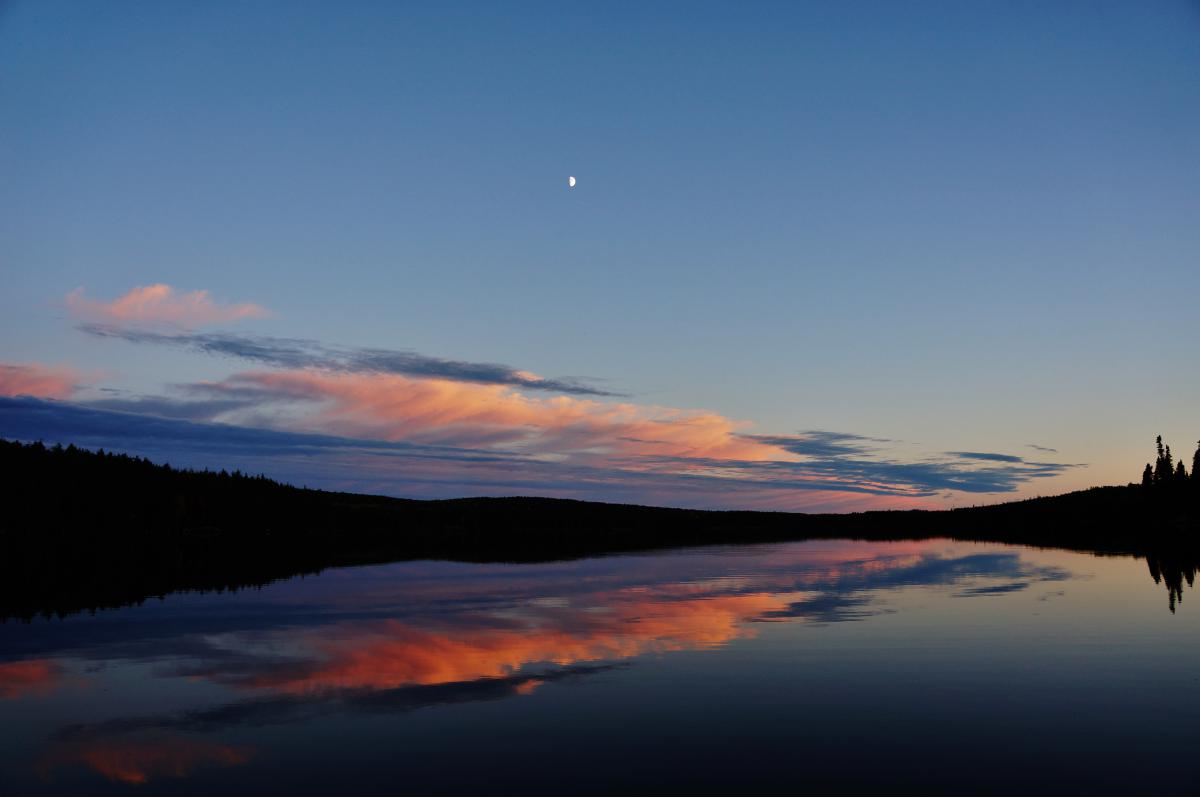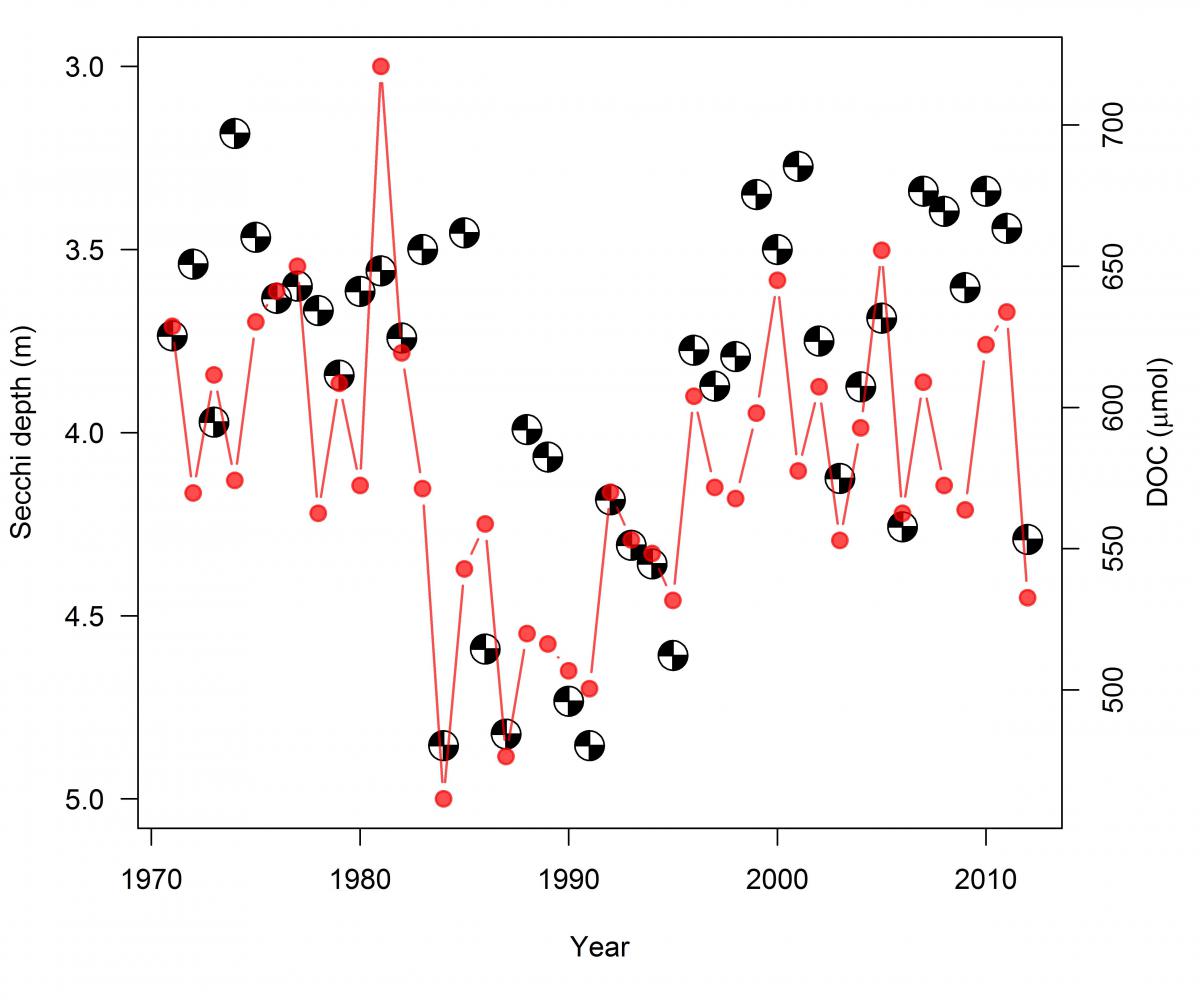In the third part of our series looking into IISD-ELA and climate change, we take a look at the effect of climate change on water clarity and learn lakes are getting darker. Here we explore why that is happening and why it matters.

- Across Europe and many parts of North America, there have been a growing number of reports that lakes are getting darker.
- This is due to many factors, but the main reason is the increased addition of dissolved organic carbon (DOC) entering into our lakes through precipitation. If you have ever looked into a wetland or lake and seen the dark brown colour of the water, that is DOC.
- In Figure 1 below, you can see that, in Lake 239, both DOC and water clarity change in similar fashion to the long-term patterns in precipitation. The early 1970s were a wet period, with above-average rainfall leading to high DOC levels and low water clarity. The 1980s and early 1990s, however, were a dry period with below-average rainfall, with reduced DOC and increased water clarity. After 1995, annual rainfall increased, DOC increased and water clarity declined.

Figure 1. Long-term patterns in water clarity (Secchi depth in metres) and DOC (mg/L) in Lake 239 of IISD-ELA.
- There is more to the story. In Eastern Canada, climate projections suggest that lakes will get darker, whereas in Western Canada, they will be getting lighter.
- Since changes in water clarity are largely controlled by changes in precipitation, changes in water clarity with future climate change will most likely depend on changes in regional precipitation patterns. Climate projections for Eastern Canada suggest increases in precipitation, which will lead to a further “browning” and loss of water clarity. In Western Canada, regional climate projections suggest reduced precipitation, which will most likely lead to increases in water clarity. Since water transparency is a fundamental parameter affecting many lake properties such as light and heat penetration, lake temperatures, photosynthesis and visual predation, climate change effects on precipitation will play an important role in shaping aquatic food webs.
- Why does this matter?
- Water clarity is an important feature of lakes, determining how much light and heat penetrate beneath the water surface, and what sorts of species can live there. Because light is a requirement of photosynthesis (plant growth), variations in water clarity can determine how much plant growth can occur and how much food and energy are available to support the food web.
- Many fish species are visual predators, meaning they need sufficient light to see their prey. The depth to which light penetrates into lakes is also important for how heat is distributed in lakes. When water clarity is high, light and heat penetrate deeper. While this may be positive for some species, particularly for those species living in warmer surface waters, for cold water species such as lake trout it can mean a loss of habitat. This habitat loss occurs when warm surface waters are pushed downwards, leaving little cool or cold water habitat, especially in shallow lakes where cold water habitat is already marginal. Unlike mammals, fish are not capable of regulating their body temperature, so changes in water temperature can have a large impact on their growth, feeding and reproductive success.
IISD-ELA, Climate Change and the Boreal Forest
IISD-ELA is located in the boreal forest, which represents the largest ecozone on the planet, covering 11 per cent of the planet’s total surface. Within Canada, the boreal forest dominates the landscape, covering 53 per cent of the total land surface. The boreal forest and aquatic systems play a large role in the global carbon budget.
However, the boreal ecozone is changing. A history of more intensive land use, industrial development, electricity generation and resource extraction alter the natural balance in minor and major ways. Most importantly, a changing climate affects water, land and life. Responsible use of our natural resources requires a scientifically rigorous understanding of these systems and how they are changing. Fortunately Canada’s premier freshwater research station has a front row seat and a history of monitoring parameters that can tell us how the world’s northern forests and freshwater lakes are affected by these changes. IISD-ELA brings a 47 year (1969–present) history of monitoring climate, water quality and fisheries in a unique whole-ecosystem laboratory setting. Now, as a part of the International Institute for Sustainable Development, we have the opportunity to use the long-term monitoring dataset of IISD-ELA to examine how climate change is affecting boreal forests, wetlands and lakes from a consistent, long-term, whole-ecosystem dataset of significant scientific and societal value.
As the world’s eyes are focused on the Paris Climate Change Conference, we wanted to take this opportunity to present some of our major climate change research findings to you, so you can see the data for yourself and understand how climate change is affecting our lakes.
You can stay up to date with all the latest news from IISD-ELA by subscribing to our newsletter, and you can donate to the facility here.